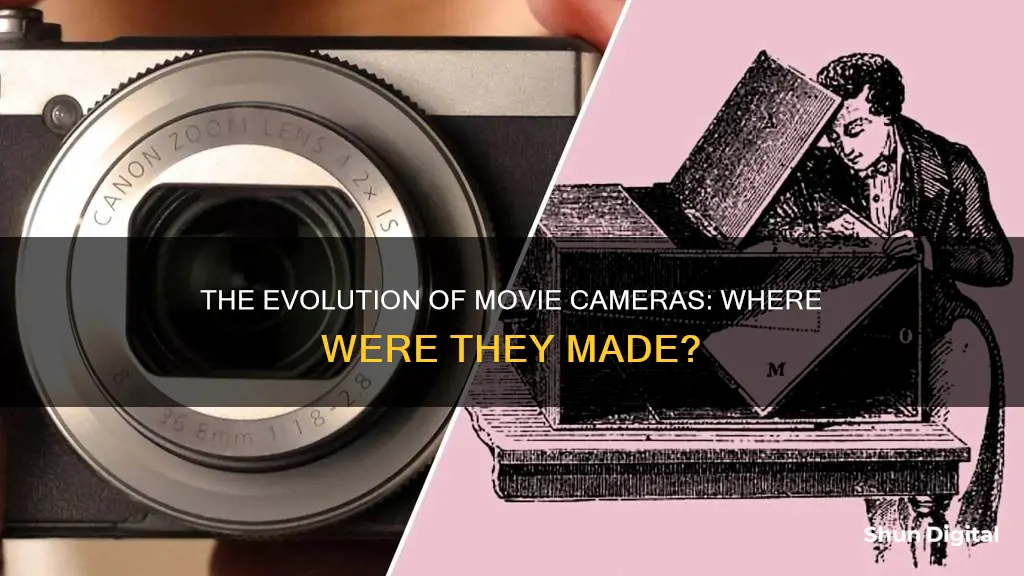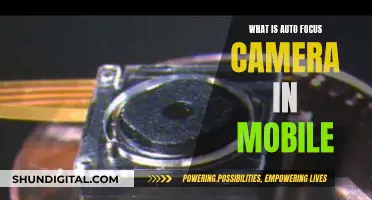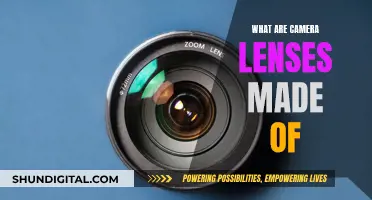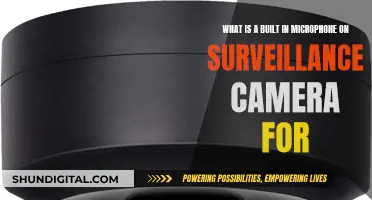
The history of the camera is a long and complex one, dating back to the early 1800s and the first attempts at capturing photographs. The movie camera, specifically, was a huge leap forward in this history, allowing for the capture of moving images and the creation of motion pictures. But who invented the first movie camera and where was it made? This question has sparked much debate and remains a mystery to this day.
The first movie camera is often credited to Thomas Edison, the renowned American inventor who, along with his British assistant William Dickson, created the Kinetograph, a primitive motion picture camera, in 1890. However, the key word here is patented, as Edison was known to patent inventions that were not fully his own. The French inventor Louis Le Prince is now increasingly recognised as the true inventor of the first movie camera, using it to shoot what is considered the first-ever movie in Leeds, England, in 1888. Le Prince mysteriously disappeared before he could patent his invention or bring it to America, and the credit largely went to Edison.
The birth of cinema as we know it today can be traced to multiple inventors and their contributions, including the Lumière brothers who, along with their assistant Charles Moisson, adapted celluloid film for their camera and projector, leading to the first-ever public screening of a film in Paris in 1895. The movie camera had become a practical reality, and the first firms for its manufacture soon emerged, solidifying its place in history.
| Characteristics | Values |
|---|---|
| Date of invention | 1888 |
| Inventor | Louis Le Prince |
| First movie | Roundhay Garden Scene |
| First movie details | Brief silent movie of people walking in a garden |
| Camera type | Single-lens |
| Camera use | To record moving images onto a cylinder |
| Inventor disappearance | September 1890 |
| Patent holder | Thomas Edison |
What You'll Learn

The first movie camera
The development of the first movie camera is a story of ingenuity, competition, and controversy. Several inventors laid the groundwork for motion picture technology, but the honour of creating the first movie camera is often disputed between Thomas Edison and Louis Le Prince.
In the late 19th century, inventors and photographers sought to capture and reproduce moving images. Eadweard Muybridge, for instance, created sequential photographs of horses in motion, projecting them with his zoopraxiscope to create the illusion of movement. Étienne-Jules Marey, a French scientist, invented the chronophotographic gun in 1882, which could capture 12 images per second.
During this time, Thomas Edison, a renowned American inventor, envisioned a camera that could record moving images. In 1888, he drew up plans for such a device. Edison's employee, William Kennedy Laurie Dickson, played a crucial role in turning these plans into reality. Dickson designed the Kinetograph Camera, also known as the Strip Kinetograph, which could capture up to 50 feet of celluloid film at a rate of about 40 frames per second. This camera, developed in 1889 or 1891, is often regarded as the first motion-picture camera. Edison received a patent for the Kinetograph in 1892.
However, the story of the first movie camera takes a mysterious turn with the involvement of Louis Le Prince. Le Prince, a French inventor, built a single-lens camera and, in 1888, used it to film a brief silent movie titled "Roundhay Garden Scene." This film is the oldest surviving motion picture, providing evidence that Le Prince may have been the first to invent the movie camera. Yet, just before he could patent his invention and showcase it in America in 1890, Le Prince mysteriously vanished. His disappearance remains unsolved, with suspicions of foul play and even allegations of Edison's involvement.
In the end, the development of the first movie camera was a collaborative effort, with Edison and Dickson's Kinetograph gaining wider recognition and sparking the growth of the film industry.
Recycling Camera Batteries: Safe Disposal and Environmentally Friendly Options
You may want to see also

The Kinetograph
Dickson performed the majority of the experimentation, though Edison conceived the idea and supervised the project. The camera was developed in Edison's laboratory in West Orange, New Jersey, and was used to shoot some of the earliest films, including "Monkeyshines, No. 1" in 1889 or 1890, and "Edison Kinetoscopic Record of a Sneeze" in 1894.
Camera Battery Life: AA Power Explained
You may want to see also

Thomas Edison and William Dickson
The development of the movie camera is a story worthy of Hollywood, with competing claims from inventors, the unexplained disappearance of one of them, and even accusations of murder.
The first movie camera is often credited to Thomas Edison, the American inventor of the lightbulb and the phonograph, among other things. However, it was actually his British assistant, William Dickson, who invented the Kinetograph, a motion-picture camera, and the Kinetoscope, an early movie projector.
Dickson was inspired by previous works such as Eadweard Muybridge's sequential series of photographs of a horse's hooves in rapid motion, taken to settle a bet. Muybridge's work led to the development of the zoetrope, a simple toy that made it possible to view a series of pictures in rapid succession, creating the illusion of motion.
In 1888, Edison conceived of a device that would "do for the eye what the phonograph does for the ear". He filed a preliminary claim with the US Patent and Trademark Office, outlining his plans for the device, which he named the Kinetoscope. Dickson, then the official photographer for the Edison company, was assigned to turn the concept into a reality.
Dickson and his team at the Edison lab developed the Kinetoscope viewing machine, with the first working prototype unveiled in May 1891. They also devised the Kinetograph, a motion-picture camera that could photograph films for in-house experiments and commercial Kinetoscope presentations, at speeds of up to 46 frames per second.
The Edison Manufacturing Co. (later Thomas A. Edison, Inc.) built the apparatus for filming and projecting motion pictures and also produced films for public consumption. The company's early films were actualities showing famous people, news events, disasters, people at work, new modes of travel and technology, scenic views, expositions, and other leisure activities.
Despite Edison and Dickson's pioneering work, it is now increasingly accepted that the first movie camera was actually invented by Louis Le Prince, a Frenchman who had emigrated to England. Le Prince used his camera to shoot what is likely the first-ever movie in Leeds in 1888. The film, now known as "Roundhay Garden Scene", shows Le Prince's adult son Adolphe and another unidentified man, along with two unidentified women, leaving a country house to go for a walk.
So, why does Edison get most of the credit and not Le Prince? In part, this is because Edison was the first to name, patent, and mass-produce a movie camera. However, another reason is Le Prince's mysterious disappearance. He had planned to travel to New York to unveil his new camera but never arrived. He boarded a train in Dijon, France, but never reached his destination, and neither he nor any of his belongings were ever found. There have even been allegations that Thomas Edison was involved in his disappearance, though no evidence has ever been found to support this theory.
Charging Your FinePix Camera: A Step-by-Step Guide
You may want to see also

Louis Le Prince's disappearance
On 16 September 1890, Louis Le Prince, the French inventor of an early motion-picture camera, disappeared without a trace. Le Prince was last seen boarding a train from Dijon to Paris. When the train arrived at its destination, Le Prince was not on board, nor were his bags. No trace of him was ever found.
Le Prince's disappearance remains a mystery. There are several theories about what might have happened, but no evidence to support any of them conclusively.
One theory is that Le Prince was murdered by his brother, Albert. Albert was the last person to see Le Prince alive and owed him a significant amount of money. However, there is no evidence of any animosity between the brothers, and Le Prince was excited about his new invention and the prospect of demonstrating it to his wife in New York.
Another theory is that Le Prince was assassinated by Thomas Edison or his associates. Edison was a rival inventor who would later claim credit for inventing the motion-picture camera. He was known for his aggressive business practices and exploitation of other people's inventions. However, there is no direct evidence linking him to Le Prince's disappearance.
Other theories include suicide, disappearance to start a new life, and murder by a robber. Le Prince's widow believed that Edison was responsible, but no conclusive evidence has ever been found.
The Evolution of Camera Technology: Advancements and Innovations
You may want to see also

The Lumière brothers
By 1894, the Lumière family was producing around 15 million plates per year. That same year, Antoine Lumière, the brothers' father, attended a demonstration of Thomas Edison's Kinetoscope in Paris. Upon his return, he encouraged his sons, Auguste and Louis, to create a cheaper alternative to Edison's peephole Kinetoscope and its bulky counterpart, the Kinetograph. The brothers took up the challenge, and by early 1895, they had developed their own device, the Cinématographe.
The Cinématographe was a groundbreaking invention. Much smaller and lighter than the Kinetograph, it weighed around 5 kilograms (11 pounds) and was operated with a hand-powered crank. The device could both photograph and project film at 16 frames per second, a slower speed than Edison's device, making it less noisy and more film-efficient. The key innovation was the mechanism for transporting film through the camera, inspired by the intermittent movement of a sewing machine. This process, designed by Louis Lumière, allowed the film to advance and then retract, leaving it stationary during exposure.
Mastering Camera Mode in Elite Dangerous
You may want to see also
Frequently asked questions
The first movie camera was invented by Louis Le Prince, a Frenchman who emigrated to England. In 1888, Le Prince built a single-lens camera and used it to film "Roundhay Garden Scene", often cited as the first-ever movie. However, Thomas Edison and his assistant William Kennedy Laurie Dickson are often credited with the invention of the first movie camera, the Kinetograph, patented in 1892.
The first movie camera was likely invented in England, where Le Prince was based. However, the Kinetograph was developed in the United States, particularly in New York City, where Edison was based.
The first movie camera was invented in 1888 by Le Prince. The Kinetograph was unveiled in 1890 and patented in 1892.
The first movie camera invented by Le Prince did not have a name, but the one invented by Edison and Dickson was called the Kinetograph.







